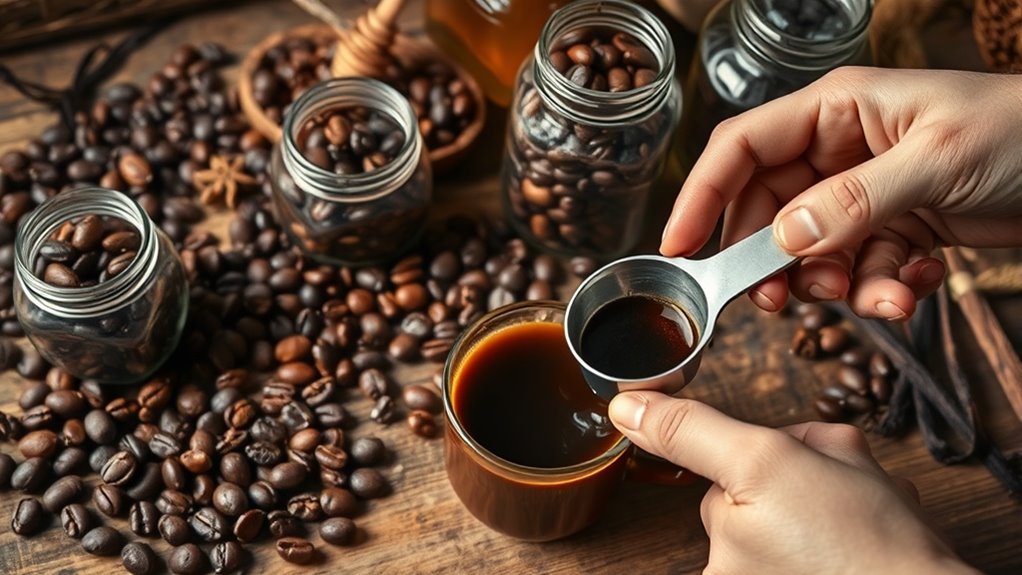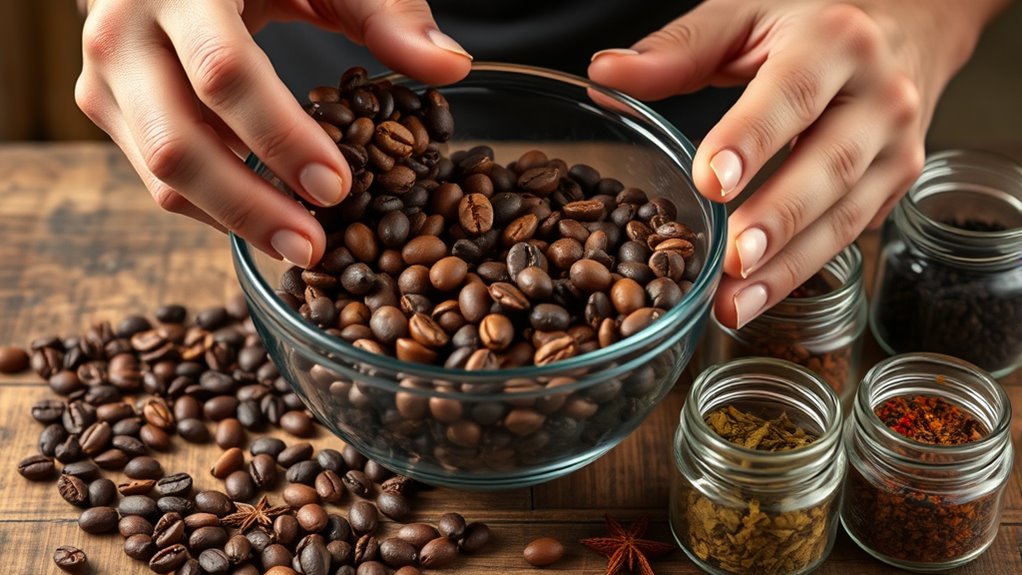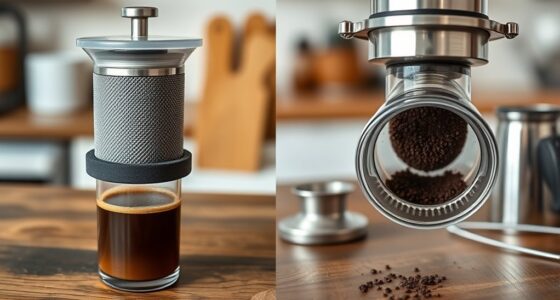To create your own signature coffee blend, start by selecting high-quality beans from different origins to develop unique flavors. Experiment with roasting times and temperatures to find the perfect level that highlights your preferred notes, whether fruity or smoky. Keep detailed notes of your process, blending and tasting Small batches to refine your taste profile. With practice, you’ll master techniques to craft a personalized brew that suits your exact preferences—continue exploring to unseal more tips.
Key Takeaways
- Select high-quality beans from different origins to create a complex flavor profile.
- Experiment with roasting levels and times to highlight desired taste notes.
- Taste small batches regularly to identify dominant flavors and adjust blends accordingly.
- Document roasting parameters and flavor outcomes to refine and replicate your signature blend.
- Practice and curiosity are essential for developing confidence and personalizing your unique coffee blend.

Have you ever wondered how to create your perfect cup of coffee at home? The secret lies in understanding coffee roasting and flavor profiling. When you start crafting your own blend, you gain control over every aspect of the process, from selecting beans to roasting techniques. Coffee roasting is essential because it influences the flavor profile, revealing different aromas, acidity levels, and body in your final brew. Lighter roasts tend to highlight bright, fruity notes, while darker roasts emphasize bold, smoky flavors. By experimenting with roasting times and temperatures, you can develop a unique flavor profile that matches your preferences.
Master the art of coffee roasting to craft personalized, flavorful brews that perfectly suit your taste.
To begin, choose high-quality beans from different origins—Ethiopian, Colombian, or Sumatra, for example. Each origin offers distinctive flavor profiles, which you can combine to create a complex and balanced blend. Once you’ve selected your beans, consider small batch roasting at home, which allows you to refine your technique and better understand how roasting impacts taste. During roasting, pay close attention to color changes and the aroma that develops. Light roasts preserve the beans’ innate fruit and floral notes, while medium roasts bring out more caramel and nutty flavors. Dark roasts will develop a more intense, smoky character. The key is to find the right balance that complements your taste preferences.
Flavor profiling comes into play once your beans are roasted. Think of it as creating a map of taste—sweet, sour, bitter, salty, and umami—so that you can craft a blend that’s tailored to your palate. Start by tasting small batches of roasted beans, noting the dominant flavors and how they interact. Adjust your blend by adding different beans or roasting some more to deepen certain notes. This iterative process helps you develop a personalized flavor profile that resonates with your palate. Additionally, understanding the flavor impact of roasting levels can help you tailor your process to achieve specific taste characteristics.
As you continue to experiment, keep detailed notes on roasting times, temperatures, bean origins, and the flavor outcomes. This documentation will help you replicate your favorite blends or refine them further. Remember, creating a signature coffee blend is an art as much as it is a science. It takes patience, curiosity, and a willingness to learn from each batch. With practice, you’ll gain confidence in your roasting skills and develop a deep understanding of flavor profiling. Before long, you’ll be brewing a cup that’s perfectly tailored to your taste, making every morning a special ritual.
Frequently Asked Questions
What Are the Best Coffee Beans for Blending?
When choosing the best coffee beans for blending, you should consider flavor profiles and bean origins. Opt for beans with complementary tastes, like a bright Ethiopian bean paired with a smooth Colombian. Experiment with different origins—Africa, Central America, or South America—to find the perfect balance. By combining beans with diverse flavor profiles and origins, you create a unique, well-rounded blend that suits your taste preferences.
How Do I Store My Custom Coffee Blend?
Did you know that fresh coffee maintains its flavor for about two weeks after roasting? To keep your custom blend tasting great, follow these storage tips. Store it in an airtight container away from light, heat, and moisture. Keep it in a cool, dark place to preserve flavor and aroma. Avoid refrigerating or freezing, as this can cause condensation and affect freshness. Proper storage guarantees your blend stays delicious longer.
Can I Blend Decaffeinated Beans Effectively?
Yes, you can blend decaffeinated beans effectively. You should consider decaffeination methods like Swiss Water or CO2 extraction, as they affect flavor profile compatibility. When blending, choose decaf beans with complementary flavor notes to maintain a balanced taste. Experiment with small batches first, adjusting ratios until you achieve your desired flavor. Proper storage also helps preserve the beans’ quality and flavor, ensuring your blend remains fresh and flavorful.
How Long Does My Homemade Blend Stay Fresh?
Your homemade coffee blend stays fresh for about 2 to 4 weeks if stored properly. To maximize flavor preservation, keep it in an airtight container away from light, heat, and moisture. Coffee bean aging can cause loss of aroma and taste over time, so it’s best to grind your beans just before brewing. Regularly check for any stale or off smells to ensure your blend remains vibrant and flavorful.
What Equipment Is Essential for Blending Coffee at Home?
While blending coffee at home might seem simple, essential equipment makes all the difference. You’ll want a good coffee grinder for measuring accuracy and consistent grind size, along with a digital scale for precise measurements. Don’t forget cleaning tools for equipment maintenance—clean gear guarantees fresh flavors. With these tools, you’ll craft your signature blend with confidence, enjoying the perfect balance of flavors in every cup.
Conclusion
Creating your own coffee blend is like painting with flavors, each bean a vibrant hue on your canvas. As you craft your signature brew, you’re blending memories, dreams, and daily rituals into a unique masterpiece. Your custom blend becomes more than just coffee — it’s a symbol of your personality and passion. Sip slowly, and let each cup remind you that the greatest creations come from your own inspired hands.









